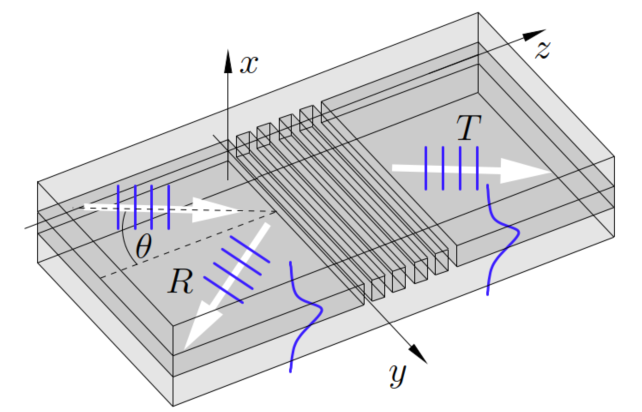Manfred Hammer, Henna Farheen, Jens Förstner
How to suppress radiative losses in high-contrast integrated Bragg gratings
In a context of photonic integrated circuits, waveguide Bragg gratings are frequently used for purposes of
spectral filtering. If these are build from material systems with high refractive index contrast
and/or with large corrugation depths, wave propagation through finite devices tends to be accompanied
by radiative losses, which are highly unwanted for certain applications such as optical signal-processing,
sensors, or lasing reflectors.
We have recently explored the properties of gratings with simple rectangular
corrugations and 1-D periodicity, as exemplified in the figure. The structures are excited
by ``semi-guided waves'' that are strictly confined in the direction perpendicular to the guiding slab,
that have in-plane the form of a plane wave, and that come in at the grating at an oblique angle.
It turns out that the oblique excitation makes all the difference: For a sufficiently high angle
of incidence, radiation losses, originating either from the corrugated region or from the interfaces
between the grating and the original slab, are (mathematically) strictly suppressed. In the band-structure
analysis, the concept of a "light line" does not apply. Further, by virtue of symmetry arguments, polarization
conversion is strictly prohibited.
Our results cover a series of fully- and partly-etched finite gratings, for typical parameters
from silicon photonics, and for TE-excitation at 45°. The devices generate a reasonably flat-top wavelength response; apodization
can lead to even more box-shaped spectra. Transmittance and reflectance add up to one in all cases.
Together with a narrow-band Fabry-Perot filter based on similar principles, these configurations exhibit
reflection bands, or transmittance peaks, with widths that span three orders of magnitude.
Details of the study can be found in a recent publication in JOSA B, see:
https://opg.optica.org/josab/abstract.cfm?uri=josab-40-4-862


